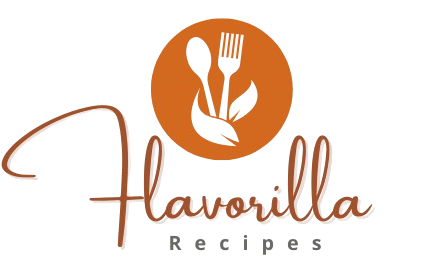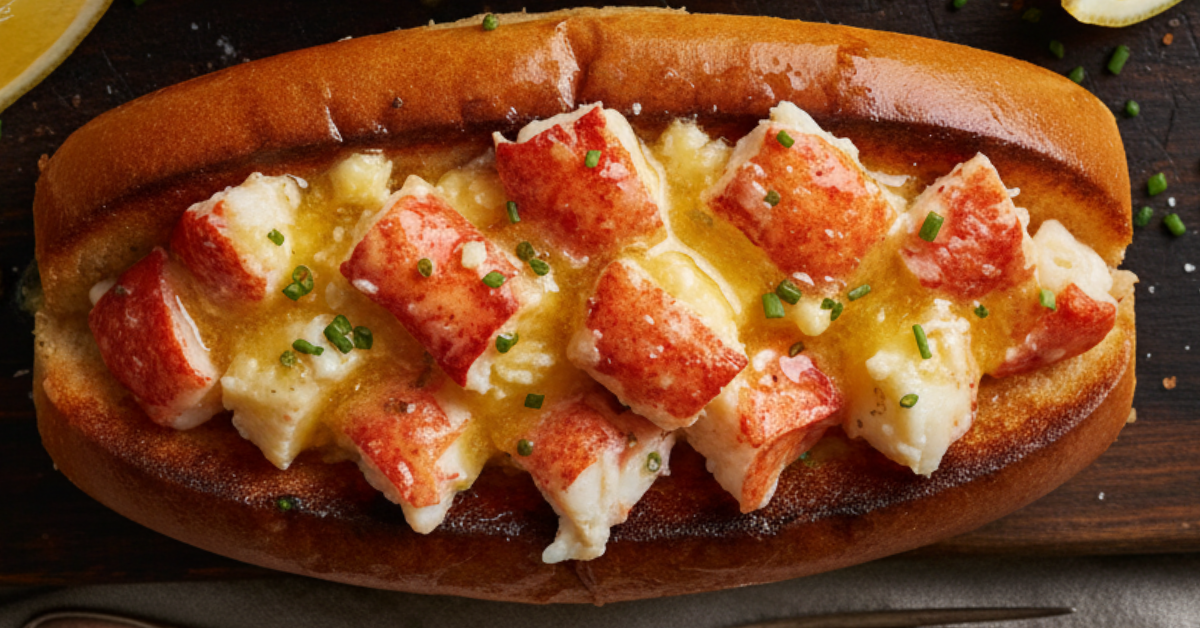The **lobster roll recipe** is the quintessential taste of summer and coastal New England. It’s a deceptively simple sandwich that sparks a major regional debate: the cold, creamy Maine style versus the hot, buttery Connecticut style. Whether you prefer yours dressed with mayo or drenched in drawn butter, mastering the **lobster rolls recipe** means learning the essential techniques for cooking the lobster just right and perfecting the roll.
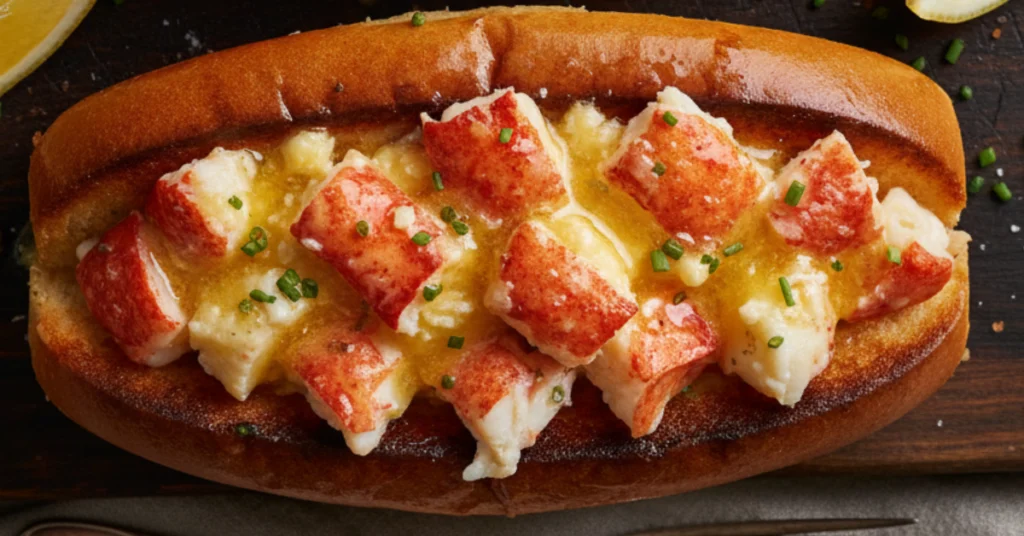
This ultimate guide provides both classic preparations, ensuring you can recreate the authentic flavors of the coast in your own kitchen. This fast, satisfying seafood sandwich is an excellent fit for **Lunch** and quickly becomes a staple among your **Quick Recipes**.
- The Essential Guide to the Best Lobster Roll Recipe
- Maine vs. Connecticut: Mastering the Two Styles
- Step-by-Step Instructions: Preparing Your Lobster Roll
- Deep Dive: Ensuring the Best Lobster Roll Recipe Texture
- Variations, Pairings, and Storage
- Conclusion: The Ultimate Guide to New England’s Icon
- → Essential Prep
- → Maine Style (Cold & Creamy)
- → Connecticut Style (Hot & Buttery)
- Tools You’ll Need
The Essential Guide to the Best Lobster Roll Recipe
The success of any **lobster roll recipe** begins with three non-negotiable components: the lobster, the buttered roll, and the dressing. Here’s what sets the truly **best lobster roll recipe** apart.
Sourcing and Cooking Lobster Meat: The Secret to Tenderness
Chewy, rubbery lobster meat is the enemy of a great roll. Since the meat is the star of the show, its quality and cooking method are paramount.
- **The Cut:** Use meat from the tail, claws, and knuckles. The claw meat is the most tender and sweet, while the tail meat provides the bulk.
- **Cooking Method:** The most reliable method is to steam or boil the lobster just until it is cooked through (internal temperature of $140^\circ\text{F}$), then immediately plunge it into an ice bath to stop the cooking process. This prevents the meat from becoming tough.
The Unsung Hero: The Split-Top Bun
The bread is crucial. An authentic **lobster roll recipe** uses a New England-style, split-top hot dog bun (cut on the top, not the side). These are typically brushed with butter and toasted on a griddle or in a pan until golden brown and crispy on the outside, and soft on the inside. The buttered, toasted bun provides a necessary warm, rich, and textural contrast to the cool, sweet lobster filling.
Maine vs. Connecticut: Mastering the Two Styles
The primary flavor divide in the **lobster roll recipe** world is determined by temperature and binder. This article provides instructions for both authentic versions.
1. The Maine Lobster Roll Recipe (The Cold Style)
The **maine lobster roll recipe** is characterized by being cold, creamy, and herb-forward. The focus is on letting the sweet, cold lobster meat shine, bound by just enough binder to hold it together.
- **Temperature:** Chilled.
- **Binder:** Mayonnaise (or a blend of mayo and sour cream/Greek yogurt for tang).
- **Additions:** Finely diced celery and sometimes red onion, along with fresh herbs like chives or tarragon. These additions provide a textural crunch and aromatic complexity.
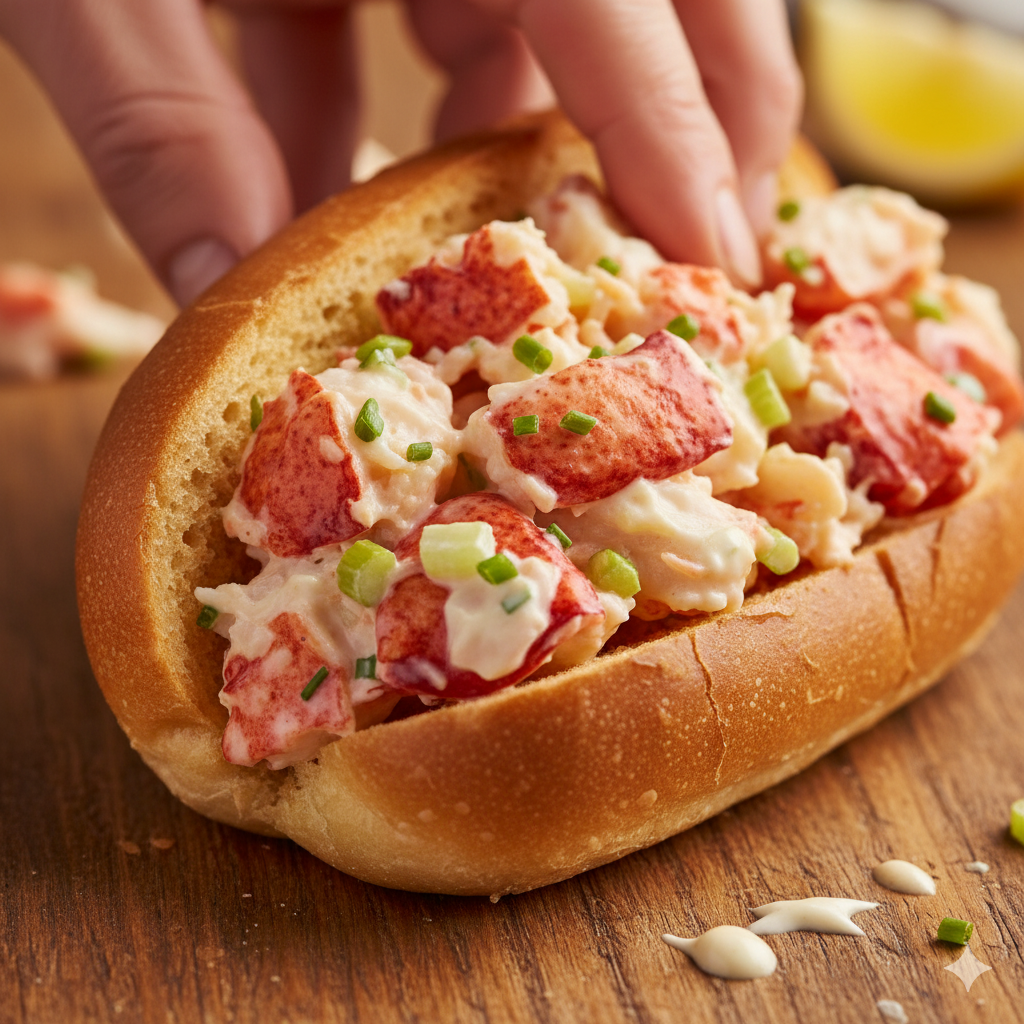
2. The Hot Lobster Roll (Connecticut Style)
The **hot lobster roll** (or Connecticut lobster roll) is simple, decadent, and savory. It relies entirely on warm butter and simple seasoning, delivering pure, unadulterated lobster flavor.
- **Temperature:** Warm/Hot.
- **Binder:** Melted clarified butter (drawn butter).
- **Additions:** Only a squeeze of lemon juice, salt, and pepper. No mayonnaise or vegetables are used in the traditional version.
This is a particularly fast dish to assemble, making it one of the most popular **Quick Recipes** for seafood lovers.
Step-by-Step Instructions: Preparing Your Lobster Roll
The base steps for preparation—cooking the lobster and toasting the bun—are the same for both styles.
- Cook and Prep the Lobster Meat: Steam or boil the lobster until cooked (about 8–10 minutes for a $1.5$ lb lobster). Immediately transfer the lobster to an ice bath to halt cooking. Once cool, remove all meat from the shells, pat dry, and cut into large, visible chunks (about 1-inch pieces).
- Toast the Buns: Preheat a skillet or griddle over medium heat. Generously brush the sides of the split-top buns with softened butter. Toast the buns for 2–3 minutes per side until golden brown and crispy. Set aside, standing upright.
- Mix the Maine Style (Cold): In a medium bowl, gently combine the chilled lobster meat with mayonnaise, diced celery, lemon juice, salt, and pepper. Add chopped herbs (chives or tarragon). **Crucially: Mix gently** to avoid shredding the lobster meat. Chill for 15 minutes before serving for the **best lobster roll recipe** flavor.
- Prepare the Connecticut Style (Hot):
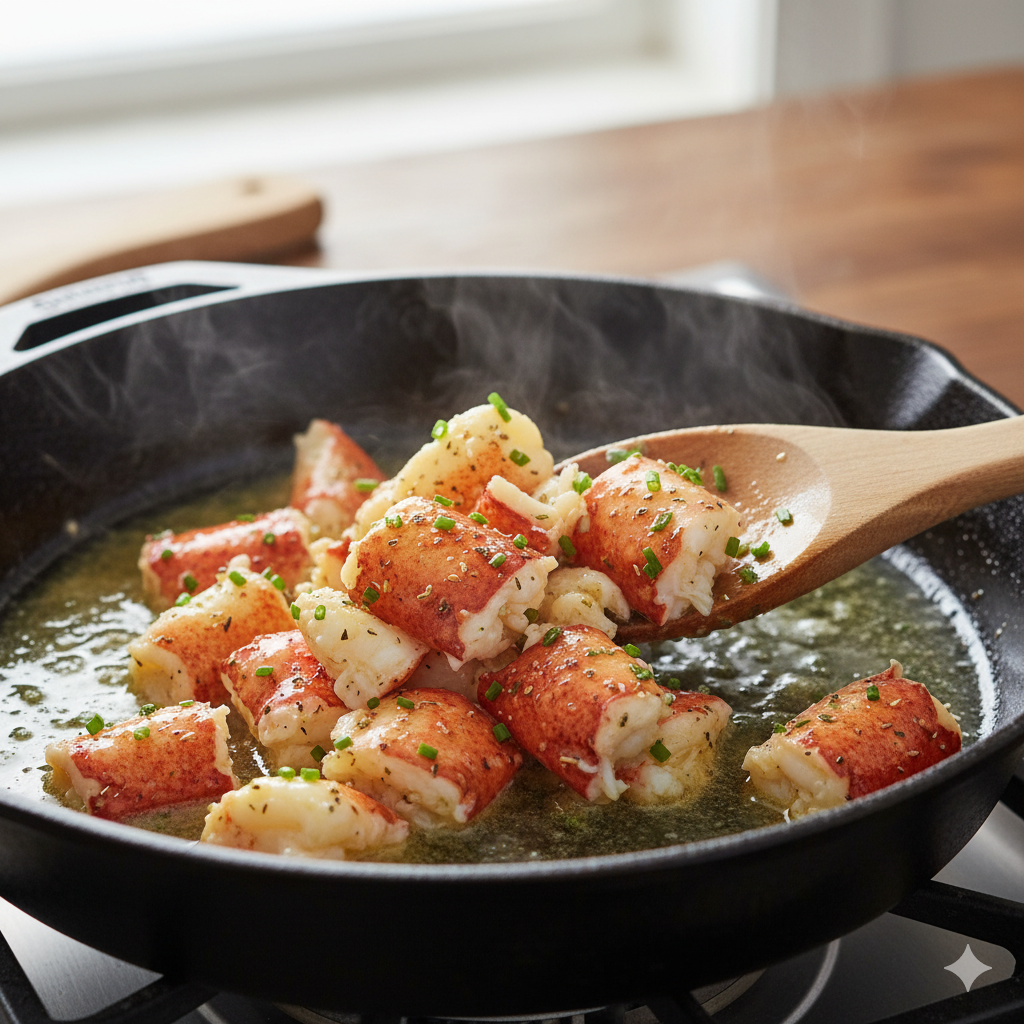
Deep Dive: Ensuring the Best Lobster Roll Recipe Texture
The hallmark of a premium, unforgettable **lobster roll recipe** is the melt-in-your-mouth tenderness of the lobster meat. This requires precise temperature control during cooking, which prevents the meat proteins from contracting excessively and squeezing out moisture. When boiling or steaming lobster, using an internal temperature probe is highly recommended; the tail meat is done at $140^\circ\text{F}$ ($60^\circ\text{C}$). Overcooking past $145^\circ\text{F}$ is the number one cause of chewy, rubbery meat, rendering even the most expensive ingredient nearly inedible. For the **Maine lobster roll recipe**, the binder choice also affects texture: avoid overly heavy mayonnaise ratios, as the dressing should accent the lobster’s natural sweetness, not smother it. The inclusion of celery or chives is not merely for flavor but for contrast, providing a necessary, snappy counterpoint to the soft, rich meat. This balance of cooking time, fat content (whether from the mayonnaise or the butter), and contrasting texture is what elevates a simple **lobster roll recipe** into a luxurious, high-quality dish worthy of being called the **best lobster roll recipe** in New England, establishing credibility and authority for the recipe.
Variations, Pairings, and Storage
The **new england lobster roll** is a versatile dish that can be paired with simple sides and adapted for quick weekday cooking.
Serving and Pairing Suggestions:
- **Classic Sides:** Serve with simple potato chips (the New England standard), coleslaw, or a small cup of clam chowder.
- **Appetizer:** For a great party appetizer, serve mini lobster rolls alongside our **[Spinach Dip Recipe]** (https://flavorillarecipes.com/spinach-dip-recipe) from our **Quick Recipes** category.
- **Heavy Meal Contrast:** For a completely opposite, hearty protein meal, try serving this light seafood sandwich as a **Lunch** contrast to a robust **[Philly Cheesesteak Recipe]** (https://flavorillarecipes.com/philly-cheesesteak-recipe).
Quick Alternatives and Substitutions:
- **Non-Lobster Rolls:** While the classic **lobster roll recipe** requires lobster, you can substitute with high-quality lump crab meat or shrimp, using the exact same preparation method (cold or hot) for a delicious seafood roll.
- **Quick Prep:** Use pre-cooked, frozen lobster meat (thawed correctly) to save time, ensuring this remains a **Quick Recipes** favorite.
Storage and Safety:
**Tuna salad recipe** and other protein-based cold salads (like the Maine roll) must be stored properly. Due to the perishable nature of seafood and mayonnaise, a **lobster roll recipe** should be consumed within 3 days if stored properly in the refrigerator. Never leave the finished salad at room temperature for more than two hours. For longer preservation, freeze the cooked, unmixed lobster meat in an airtight container for up to two months, but **do not freeze the finished salad or the buns**.
Conclusion: The Ultimate Guide to New England’s Icon
The **lobster roll recipe** is an iconic symbol of New England’s coast, offering two perfect ways to enjoy the sweet, tender meat. Whether you choose the cold, creamy comfort of the **Maine lobster roll recipe** or the warm, buttery decadence of the **hot lobster roll**, success hinges on precise lobster cooking and high-quality ingredients.
By following this ultimate guide, you can confidently prepare the **best lobster roll recipe** for your next **Lunch** or **Dinner**. This truly is a high-reward, low-effort dish that deserves a place among your favorite **Quick Recipes**.
Recipe Summary: Quick Lobster Roll
→ Essential Prep
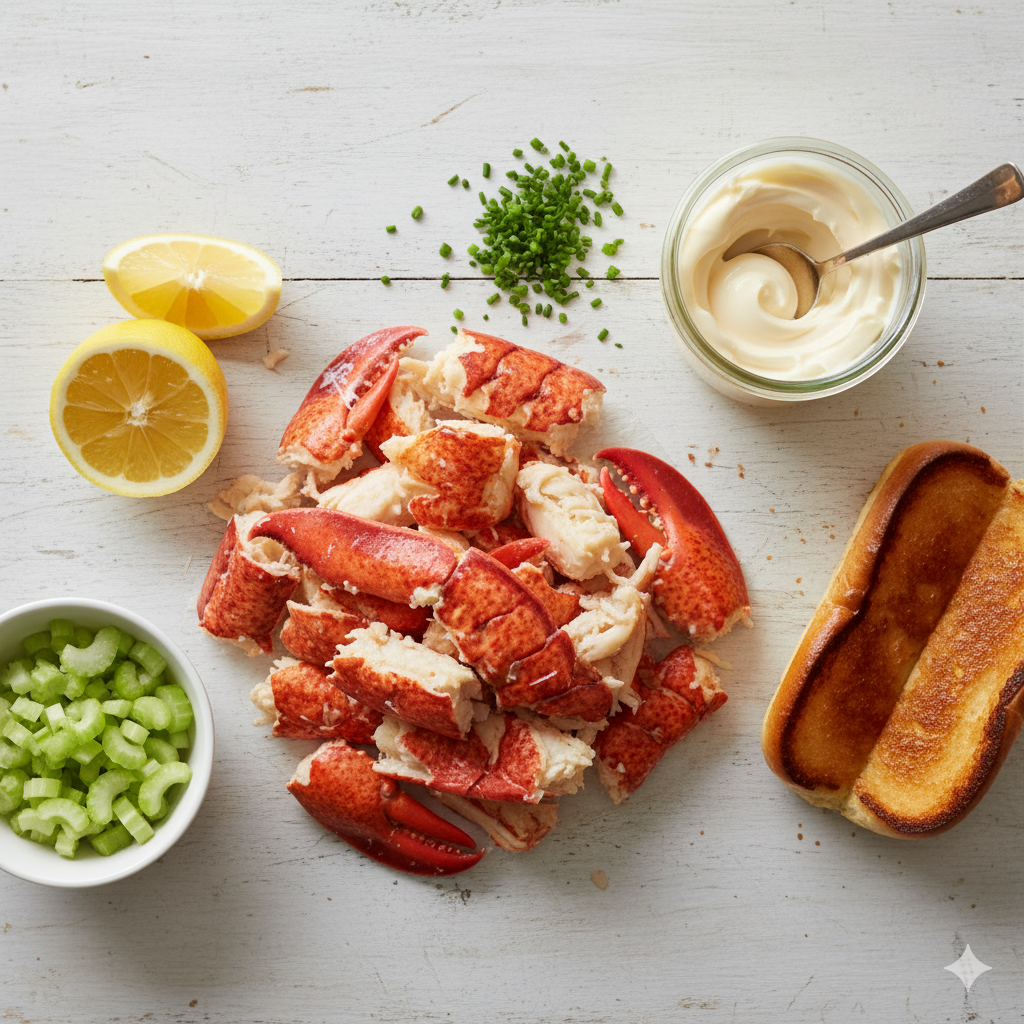
- 1.5 lbs cooked lobster meat (tail, claw, knuckle), chilled and cut into 1-inch chunks
- 4 New England split-top hot dog buns
- 4 Tbsp unsalted butter, softened and melted (divided)
- 1 tsp fresh lemon juice
→ Maine Style (Cold & Creamy)
Gently mix 1 cup of the prepared lobster meat with 2 Tbsp mayonnaise, 1 Tbsp diced celery, 1 tsp chives, salt, and pepper.
→ Connecticut Style (Hot & Buttery)
Gently warm 1 cup of the prepared lobster meat with 3 Tbsp melted butter and a pinch of salt/pepper until heated through.
Steps to Follow (The Best Lobster Roll Recipe)
- **Toast Buns:** Brush the sides of the buns with butter and grill in a skillet until golden brown and crispy.
- **Prep Filling:** Choose either the Cold (Mayo) or Hot (Butter) preparation method.
- **Assemble and Serve:** Fill the toasted buns immediately with the prepared lobster meat. Serve the Cold style chilled and the Hot style instantly, while the butter is still warm.
Tools You’ll Need
- Large pot for boiling/steaming lobster
- Large bowl and ice for chilling
- Small skillet or griddle for toasting buns
- Small saucepan for melting butter (Hot Style)
